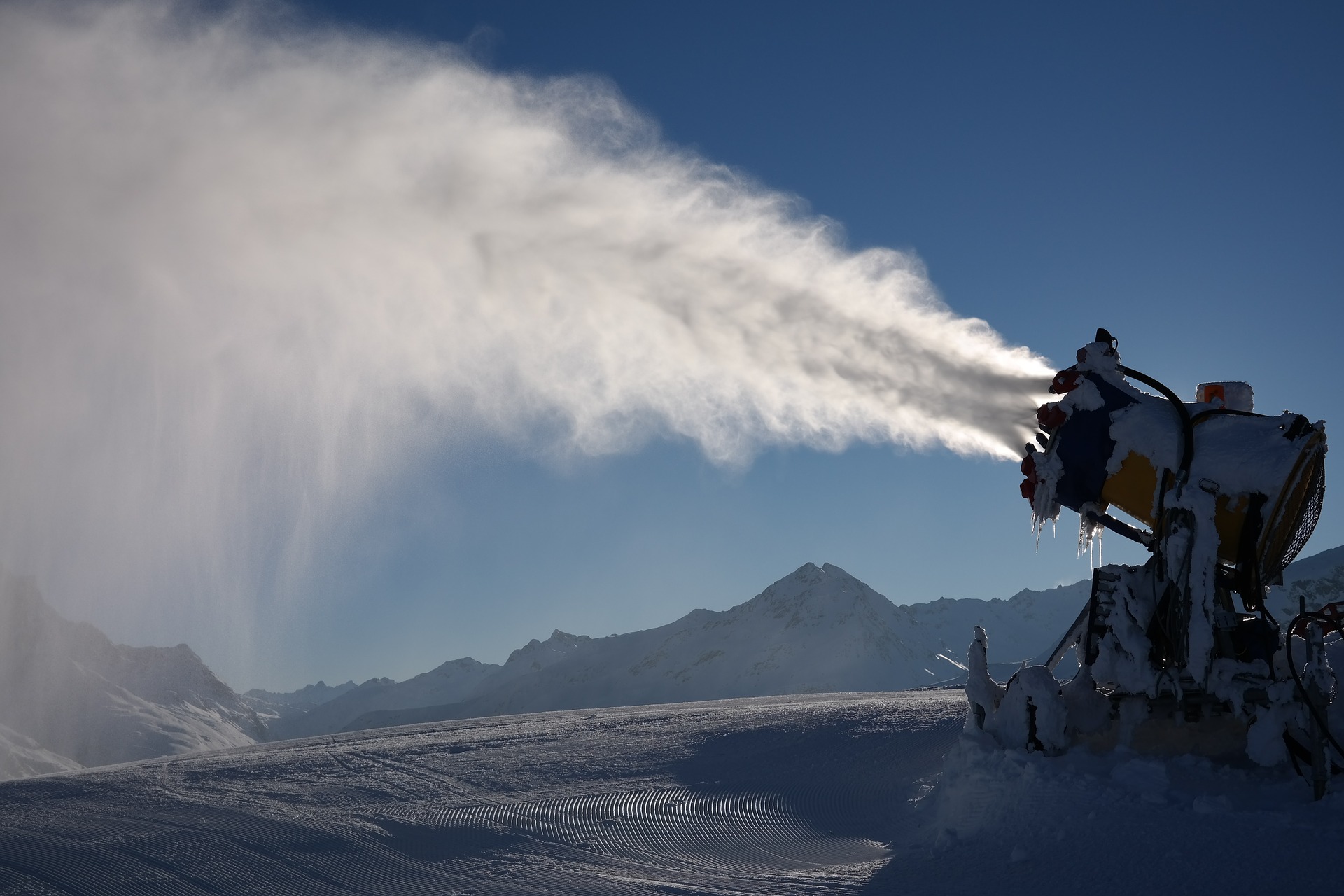Artificial snow may help the Alps now, but it comes at a cost to the future
This article was written by a participant of the Global Center on Adaptation’s Young Leaders Program. The program develops young talent to become future leaders in global climate change adaptation efforts by enhancing their knowledge, skills, and ability to thrive in an international environment.
W
hile the planet as a whole has warmed about 1° Celsius due to climate change, average temperatures in the European Alps have risen 2° C (Simon Parkin , 2019). The impacts of changing temperatures in the world are not uniform: they can depend on altitude, region and local factors. The Alps are particularly vulnerable to the impacts of climate change, with less snow and melting glaciers. For hundreds of ski resorts across the Alps, the consequences can be dramatic. Many mountain towns and villages depend heavily on snow, with the local economy up to 90% reliant on winter tourism (Unbehaun, 2016). Melting snow, meanwhile, provides water to farms and urban areas downstream and used to generate electricity through hydropower dams.
Enterprising engineers have found an adaptation technique that keeps snow on the ground, helping communities dependent on tourism: snow-machines. The first appeared in the early 1980s in Italy and were used mostly when occasional warm winters occurred. The situation nowadays is different: Alpine communities have never been so dependent on ski tourism for their survival. Today, 95% of Italian, 70% of Austrian, 65% of French, and half of Swiss ski resorts are reliant on snow machines for their economic survival. This artificial snow has helped local communities maintain their tourism, allowing thousands of skiers to enjoy their winter breaks.

Régine Roncucci
Environmental impacts
All this comes with major environmental impacts, however. The Naturschutz Federation has calculated that during the winter season, snow-machines in the Alps consume 2100 Gigawatts of electricity, equivalent to the amount of energy consumed by half a million families in one year. Moreover, for 30 cm of land with artificial snow, 1 million liters of water is needed. In the Alps there are 70,000 Ha of ski slopes, meaning 280 million cubic meters of water is used each winter season (Unbehaun, 2016). Finally, slope preparation and maintenance require the use of snowmobiles, which consume 30 liters of diesel per hour and thereby contribute to emissions and local air pollution.
For these reasons artificial snow may fail to meet its stated objective of protecting the local economy and communities – becoming a harmful adaptation strategy for the Alps’ socio-ecological systems. Indeed, climate adaptation solutions that are created to protect local communities can have unintended negative consequences (intensive water and energy consumption) and may increase vulnerability over longer timeframes. The unintended negative consequences generated by the use of artificial snow suggests it is an example of maladaptation.
Maladaptation is defined as a “process that results in increased vulnerability to climate variability and change, directly or indirectly, and/or significantly undermines capacities or opportunities for present and future adaptation” (Morrison, 2013). In other words, maladaptation does not succeed in reducing vulnerability but increases it instead. This applies to artificial snow in the Alps; an adaptation strategy that in the short term helps local communities in continuing tourism activities, but in the long-term cause further social, environmental and economic problems.

Is it causing more harm than good in the long term? Image by Hans Braxmeier / Pixabay
Diversification option
The question now is: how can alpine communities cope with a lack of snow and ensure long-term sustainable incomes? The International Commission for the Protection of the Alps (CIPRA) has over recent years worked towards ensuring eco-friendly activities in the Alps. These take advantage of the local environment and culture year-round without causing socio-ecological problems. Many communities focus almost solely on promoting holidays on the slopes, while not all tourists in the region are skiers. The CIPRA promotes other activities, such as hiking and biking, local traditions and festivals and, in winter, cross-country skiing as achievable adaptation options that can sustain tourism while respecting the environment.
The CIPRA is currently working with local municipalities in the Alps to raise awareness about the unsustainable use of snow-machines and the need to diversify tourism activities. In an era where climate adaptation is needed more than ever, it’s important to reduce the risk of maladaptation. Researchers have proposed guidelines on how to produce sustainable adaptation strategies. Current research shows that predictive analysis (ex ante) of adaptation initiatives is just as important as evaluating them after the event (Magnan, 2014).
While the latter provides monitoring of the effectiveness of implementing adaptation and using dedicated funds, ex ante analysis also plays a part in improving adaptation efforts, mainly because it helps to avoid maladaptation. This approach carries very positive news for decision-makers and practitioners in charge of implementing adaptation on the ground. Conducting ex ante analysis allows clearer understanding on the possible impacts of adaptation solutions, avoiding time and financial losses.
Moreover, various stakeholders, such as local communities in the Alps, already have empirical experience of mountain hazards and thus are able to partially understand how certain adaptation solutions could positively or negatively affect the Alps’ ecological and economic system. Finally, avoiding maladaptation is a key concrete step towards climate adaptation that requires previous monitoring of adaptation solutions as well as stakeholder collaboration from the international to the local level.
References
Magnan, A. (2014). Avoiding maladaptation to climate change: towards guiding principles. SAPI EN. S. Surveys and Perspectives Integrating Environment and Society, (7.1).
Morrison, C., & Pickering, C. (2013). Limits to climate change adaptation: case study of the Australian Alps. Geographical Research, 51(1), 11-25.
Simon Parkin, (2019). Snow machines and fleece blankets: inside the ski industry’s battle with climate change. The Guardian. Available online: https://www.theguardian.com/world/2019/dec/19/snow-machines-fleece-blankets-inside-ski-industry-battle-with-climate-change-alpine-resorts
Unbehaun, W., & Pröbstl, U. (2006). Cloudy prospects in winter sport How competitive are the Austrian winter sport destinations under conditions of climate change?
The ideas presented in this article aim to inspire adaptation action – they are the views of the author and do not necessarily reflect those of the Global Center on Adaptation.